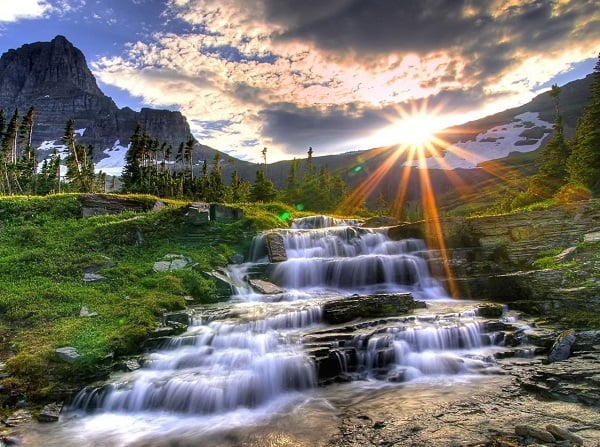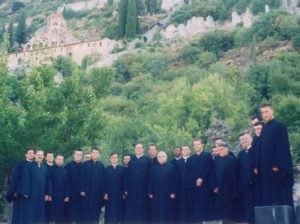The project of synergic anthropology: spiritual practice as the basics for a new conception of man (part 2)
3 October 2018[Previous post: http://bit.ly/2DDZC7z]
2. Hesychasm in the prism of anthropological reflection
Synergic anthropology starts with the complete reconstruction of hesychast anthropology[3]. Let us point out its principal elements and stages.
Hesychasm is ascetical and mystical practice of Eastern-Christian (Orthodox) Christianity which begins to form itself up together with the emergence of Christian monasticism in the 4th c. in the practice of the Desert Fathers of Coptic Egypt and Palestine. It achieves its accomplished mature form in a thousand years, in Byzantium in the 14th c. Still in the Middle Ages it spreads all over Orthodox oikumene and then undergoing many crises and breaks continues its living existence up to our days. As an historical and anthropological phenomenon hesychasm (as well as any spiritual practice) represents a dyad, a combination of individual practice and collective tradition, i.e. community which elaborates, preserves and translates the refined art of this practice, the canon of the exact and identical reproduction of its experience. Such a combination of the individual and the collective is similar to what we see in biological systems, in populations of living organisms. Each specimen in a population leads its individual existence which has the equally individual goal, the implementation of the genetic program inherent in each of its cells. However, to achieve this goal the specimen should live in a population. The belonging to a community of specimens is a necessary premise of successful existence of any individual specimen; the specimen and the community are two inseparable elements of the phenomenon of population. Then there is the so called biogenetic law according to which the development of the specimen (ontogenesis) and the development of all the population have a structural similarity, they repeat each other passing through the same principal stages. One can see that spiritual tradition, i.e. the ascetical community in its historical existence possesses also these properties of the population. Each adept of the tradition, the hesychast, does his personal way of the practice transforming himself to a certain higher state, but the passing of this way is possible only on the basis of the tradition, in the ascetical community and with its help. Even some analogue of the biogenetic law can be found here.

The way of the practice, the sui generis hesychast ontogenesis, has the structure of a ladder ascending from the starting event, the entry to the way (Spiritual Gate), to the completion of the way in which all man’s energies achieve ontological transcending which is called the deification (theosis) and is inaccessible in its fullness in man’s empiric existence. All the way, from Spiritual Gate to Theosis, is structured into three big parts or blocks. In the first block ascetical labors are still directed chiefly to the worldly way of life left behind by the hesychast. Main elements of this block are conversion, repentance and struggle with passions. Conversion and repentance should secure the resolute break with what was left behind, the worldly way of existence and order of consciousness. To this end hesychasm elaborates a rich set of specific practices of repentance which use extreme psychological states and means: sharp self-accusations, self-torture, sorrow, grief, anguish and other negative emotions, crying and tears, and sometimes also hard and painful corporeal ordeals, etc. etc. These very unusual practices were often interpreted by secular science as manifestations of psychological pathologies, but this interpretation is superficial and misleading. “Sufferings of a penitent are neither nervous disorder nor a consequence of unsatisfied passions of lust nor a psychological conflict nor the loss of reasonable control. They also do not have any other pathology. Not at all. In their nature these sufferings belong to a different order of being”[4]. In fact, all these means carry out the synergetic function of generating disbalance of man’s consciousness due to which the consciousness is brought far away from all its usual stable regimes and becomes capable to profound restructuring and radical change of the dynamics of its processes. As for the struggle with passions called also the “invisible battle” of an ascetic, it should remove the staunchest features of the worldly order of consciousness: the stable cyclic configurations of its energies making it fully concentrated on some worldly goal or emotion and hence incapable to advance to the goal of spiritual practice. Hesychasm analyzes and classifies passions and elaborates sophisticated techniques of their eradication. The corresponding steps of the Hesychast Ladder have some resemblance to practices of antiquity, first of all, stoic practices, and also to modern psychotherapy, but in both these cases considerable difference is present as well.
After the overcoming of passions the practice enters its central, “equatorial” part in which the vector of man’s attention and efforts changes its direction “from below to above”, from the empiric world to the task of achieving the encounter with a different mode of being. Now spiritual practice must perform actual advancement in the ontological dimension. The process of ascending its steps must have a nontrivial ontological content, and all usual anthropological practices do not have such property. For this reason, any spiritual practice includes the key element: the creation of the so called ontological mover, an anthropological mechanism which helps to change the ontological situation of the man, man’s relation to the other horizon of being. In hesychast practice this horizon is Divine personal being and the ascension to it is the communion with God, the main way of which is the prayer. As a result, the ontological mover created in this practice represents the combination or union of two different activities, prayer and attention. In this union the attention performs the auxiliary function; in hesychast terms, it is the guarding of the prayer which should remove all the obstacles to the prayer and all the intrusions into its process. Due to such guarding the prayer can take a special form of the incessant prayer which becomes more and more profound and intense involving all human person entirely and concentrating enormous energy directed wholly to God as the Person, to the encounter, communion and union with Christ. At the peak of this praying and striving in which the man opens and unlocks himself up to the maximum towards God, his praying communion with God becomes the actual encounter of human and Divine energies. (In the secular discourse one can say that the man identifies in himself the action of some energies the source of which is not in him and even, according to some criteria, not in his horizon of being.) Directing the total set of his energies to Christ the man achieves their encounter and their coordination, cooperation and accordance with His energies. This is the central event of spiritual practice called synergia in hesychasm. The achievement of synergia, or synergy, is the first and most important fruit of the creation of the ontological mover. That’s how St. Philotheos of Sinai (9th or 10th c.) describes this fruit: “Attention and prayer, if they are permanently combined together, perform something similar to Elias’ chariot of fire, lifting to the heavenly heights him, who has them”[5]. After this event the practice enters its last, higher block.
[3] See: S.Horujy. To the Phenomenology of Ascesis. Moscow, 1998. (In Russian.)
[4] Archimandrite Sophronius (Sakharov). See God as He is. Stauropegic Monastery of St. John the Baptist. Essex, 1985. P.89. (In Russian.)
[5] St. Philotheos of Sinai. Forty Chapters on Sobriety // The Philokalia. Vol. 3. Sergiev Posad, 1992. P.414. (In Russian.)
The distinguishing feature of this block is that the formation of its steps is now performed not as much by man’s energies as by other energies. These are the energies with which the man achieved the contact and cooperation in synergy and which started then acting in his consciousness and all his person, but nevertheless he perceives them as belonging not to him but to some external source, the source that is “beyond-there” in the strongest, ontological sense. For this reason, in man’s own perception these next steps of his transformation are more and more formed up without his efforts, spontaneously. In these steps the emergence of new forms of prayer takes place and the emergence of new abilities of the human being, and this spontaneous growth of the articulation, differentiation and structuredness in terms of system theory corresponds to the dynamics of self-organization. Since this dynamics is implemented not by man’s own energies, but by energies of the source which is ontologically beyond-there, it can achieve what is impossible for man’s energies, i.e. the actual ontological change, the change of the fundamental predicates of man’s mode of being. It means that due to synergy in the higher steps of the practice fundamental changes of the human being begin which are approaches to the final goal of the practice, the theosis. There is a large fund of ascetic testimonies saying that such changes start with the sphere of perceptions: new abilities of perception emerge which are called “intellectual senses” in hesychasm, and they are actual manifestations of a new ontological quality, according to which the man is now unlocked toward Divine being. However, the fullness of the ontological transformation, the theosis as such, is, by the very definition of it, not realizable within the limits of man’s empiric existence.

This is the structure of the way of hesychast practice in its big parts. As said above, this personal way of the hesychast, or the “ontogenesis”, has some structural resemblance to the “philogenesis” or the historical way of the hesychast tradition. Au vol d’oiseau, the complete formation of the tradition and practice takes approximately thousand years, from the 4th to the 14th c., and one can discern three big stages in this formation which are correlated directly with the three blocks of hesychast practice. In the period of the early hesychasm, the anachoresis of Desert Fathers of the 4th to the 6th cc. the emerging tradition establishes itself, in the first place, as a community which breaks with the life of the worldly society and opposes itself to this life. Thus it concentrates on problems of the rejection of worldly life, of the overcoming of its passions and all its patterns of consciousness; and all this is exactly the problems of the initial block of hesychast practice. Then there follows the stage of the so called Sinai hesychasm in the 7-10th cc. when main centers of the tradition are the monastery of St. Catherine at Sinai and other monasteries in the Sinai area. At this stage hesychast practice is formed up and conceived as an integral spiritual process, its first systematic description appears (the famous “Ladder of Paradise” by St. John of Sinai) and the problems of the ascension to the theosis are profoundly worked out which includes the discovery of the key role of the union of prayer and attention. Thus the problem of the central block of hesychast practice is solved here, the ontological mover is discovered. And finally, the late-byzantine hesychasm of the 13-14th cc. with the Hesychast controversy and theology of St. Gregory Palamas represents the last stage of the formation of the tradition. At this stage the higher steps of hesychast practice are in the focus of main efforts. Hesychasts called the experience of these steps the contemplation of the Light of Tabor, and it was essentially the experience of the formation of intellectual senses, of the approaches to the transfiguration of the human being. As a result, we see the structural similarity and the coincidence of the contents of the historical stages of the development of hesychasm, on the one hand, and stages of the personal practice of an individual hesychast, on the other hand. The general conclusion is that spiritual tradition in its historical existence represents an analogue of the population of living organisms: sui generis spiritual organism or else meta-organic system. One can add here that my concept of spiritual tradition resembles rather closely the ancient Greek conception of Polis as it is interpreted by Heidegger in his Parmenides (1942-1943). According to Heidegger, Polis was for Greeks a special and unique place where the man can actualize his relation to being unlocking himself towards being: “Polis… is the pole and center of the Greek essence. In this essential center everything is primordially united, which is addressed to the man as the unconcealed (das Unverborgene) and as something, to which the man is profoundly related in his being … Polis gives to the essent (das Seiende) the possibility to actualize itself in its being”[6].
Proceeding from the description to analysis let us point out principal features of the hesychast vision of man which are important for nonclassical anthropology. What is he, who is he, the hesychast man? Of course, the first and main thing is that he is formed-up, he acquires his personality and identity in hesychast practice which performs the actual ontological transformation of the human being. The transformation itself is performed by Divine energies while man’s task is to open or unlock himself toward these energies and achieve synergy with them. In other words, here the man forms up his constitution unlocking himself toward the other mode of being (or, more correctly, toward genuine being), performing his ontological unlocking. In classical anthropology the man forms up his constitution actualizing his essence; but here we have a different principle of constitution which does not rely upon the essence of man and even does not suppose its existence. Thus we conclude that the main anthropological principle inherent in hesychast practice is exactly the principle or paradigm of the constitution of man in the ontological unlocking. In the unlocking of man we find a way to nonclassical anthropology and one of possible lines of its development.
Besides the generating principle, new anthropology needs also a discourse, a framework making it possible to ascribe signifiers to anthropological reality and form up anthropological concepts. In this aspect, classical anthropology was heuristically perfect: one and the same concept of essence determined both the constitution of man and anthropological discourse which was “essentialist discourse”, i.e. based on the logic of essences. But in hesychast anthropology we can also find a certain discourse which is not essentialist and is closely connected with the unlocking of man. The key notions of hesychasm are synergy and theosis, and they both are of energetic nature: synergy is the encounter and collaboration of human and Divine energies, and theosis is the complete union of these two kinds of energies. And this implies that hesychast practice, being the way to synergy and theosis, has human energies as its direct subject field. Ascetic labor of any hesychast is the successive transformation of all the set of his energies, and each step of hesychast practice can be considered as a certain type or configuration of the set of all man’s energies. It means that the hesychast discourse on man is a discourse on man’s energies which does not include abstract essentialist categories; in other words, hesychast anthropology develops in the discourse of energy which is radically different from the essentialist discourse.
[6] See M.Heidegger. Parmenides. St.-Petersburg, 2009. Pp.196-197 (in Russian).
Here an important proviso should be made, however. It should be taken into account that the notion of “human energies” is not a proper philosophical notion stricto sensu, it lacks precise philosophical meaning. This anthropological notion is not a derivative notion or a particular case of the metaphysical and ontological category of energy which is present in the Aristotelian or neoplatonic discourse. In the ascetical discourse “human energies” are not related to metaphysics, but represent a working tool of practical anthropology, a terminus technicus with the extremely wide semantic field: it designates any actions and manifestations of man, both in his outer and inner reality; what is more, these manifestations may be not finished and full-fledged acts, they may remain on the “embryonic” level of “germs of acts” or “energies of consciousness” called “thoughts” (logismoi) in hesychasm and representing all kinds of inner movements, urges, etc. In order to draw the demarcation line with the metaphysical category I use the term “anthropological manifestations”. Thus it can be said that synergic anthropology develops the discourse of anthropological manifestations which represents an alternative to the essentialist discourse and is a variety of the discourse of energy.
One more property of hesychast practice as a pool of pure anthropological experience is important. We found that synergy represents the unlocking of man, but it is necessary to point out some characteristics of this unlocking. The unlocking is one of the most general modalities of the human being. In various forms we perform our unlocking all the time: one has only to remind that the man unlocks himself to surrounding sensual reality in any of his perceptions. The distinguishing feature of the unlocking in synergy is that it is a constitutive unlocking: in this unlocking the constitution of man is formed-up, the structures of his personality and identity. This property is closely connected with the fact that in this case the unlocking is realized in extreme anthropological experience, i.e. such experience in which the man reaches the boundary of the horizon of his consciousness and his existence meeting something (or Somebody as in the Christian experience) which does not belong to this horizon and hence is the Other with respect to the man as such. Evidently, the experience of the unlocking in synergy which is the unlocking towards the Ontological Other is a kind of extreme experience. Thus hesychast practice is a certain form of extreme anthropological experience, and the paradigm of human constitution that it contains is the constitution in extreme anthropological manifestations actualizing the ontological unlocking. Close connection of man’s constitution with his extreme experience is one of leading ideas in modern nonclassical philosophy as well as in studies aiming to understand new anthropological practices and processes[7]. That’s why the remark that hesychast experience is extreme experience is important for the advancement from the initial experiential base.
(to be continued)






